Abstract
OBJECTIVE: Current therapy for small invasive breast cancer, particularly when discovered mammographically, was re-examined. Axillary dissection may be avoided when lymph node metastases incidence is low (< 10%) or when primary cancer features determine adjuvant therapy. Radiation therapy may be avoided when risk of recurrence is very low. SUMMARY BACKGROUND DATA: Recent studies by the Surveillance, Epidemiology, and End Results program (SEER) have shown increases in small invasive breast cancers (< 1 cm) attributable to mammographic screening. The incidence of axillary metastases in mammographically discovered small cancers (< 1 cm) may be less than 10%. Follow-up data from the Breast Cancer Detection Demonstration Project (BCDDP) indicate a disease-free survival rate exceeding 95% at 8 years if the cancer was discovered mammographically. METHODS: Maximum diameter and lymph node metastases of invasive breast cancer diagnosed between 1969 and 1988 were analyzed and compared to cases diagnosed between 1929 and 1968. One hundred thirty patients have been treated without either axillary dissection or radiation therapy since 1980. RESULTS: The mean and median diameters of invasive breast cancers decreased to 2.31 and 2.0 cm, respectively, between 1984 and 1988; 13% were less than 1 cm in diameter. Only 13% of patients had axillary metastases if the primary cancer was 1 cm or less in diameter in the last 10 years; 71% had only 1 or 2 nodes involved. Isolated local recurrence, total local recurrence, and distant metastases were unchanged when radiated and nonirradiated patients were compared. Axillary nodal recurrence was decreased in irradiated patients because the lower half of the axilla was treated. CONCLUSION: In selected patients with very small invasive breast cancers detected by mammography, breast conservation without axillary dissection or radiation therapy may be used. Entirely outpatient treatment markedly reduces morbidity and cost, and furthers the gains from screening programs.
Full text
PDF
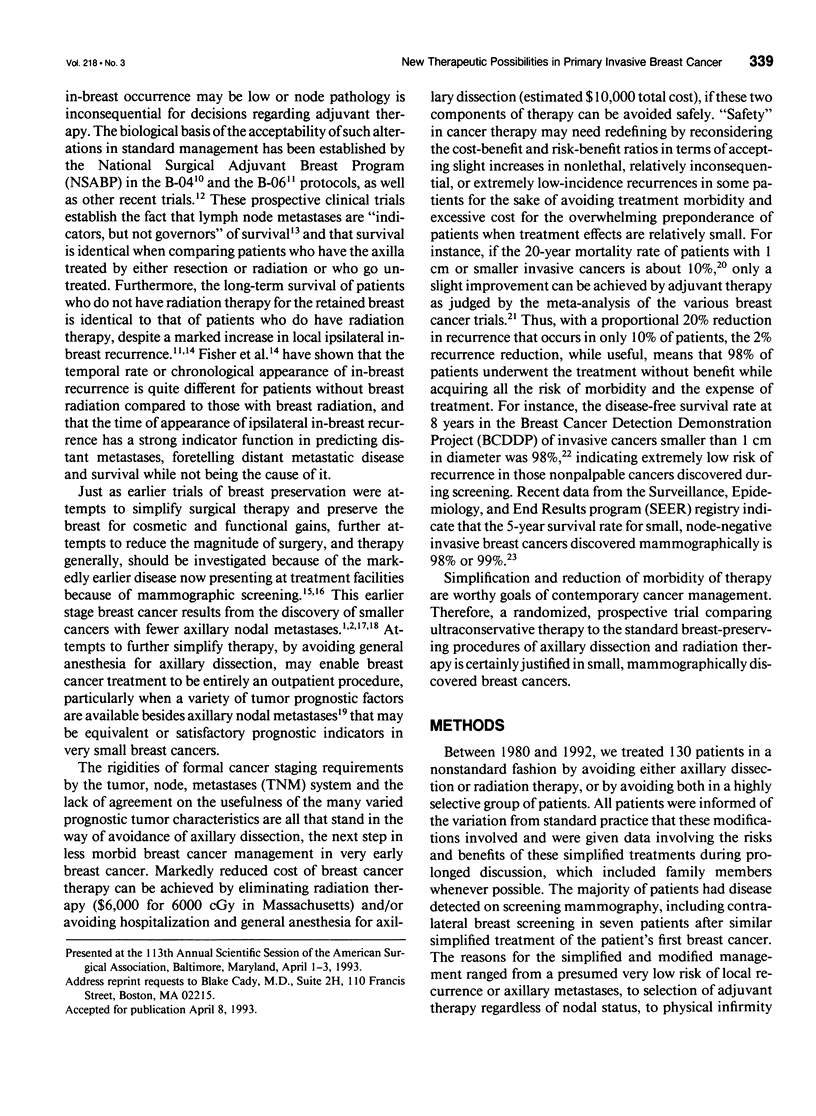
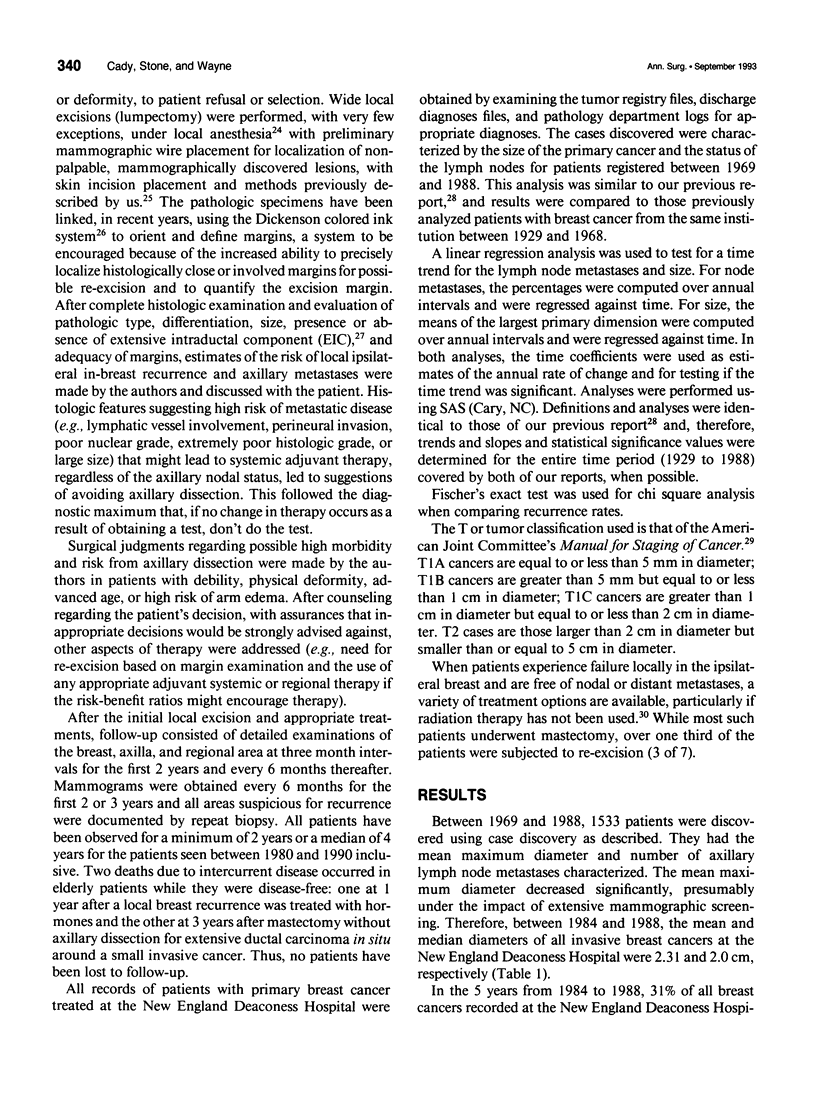
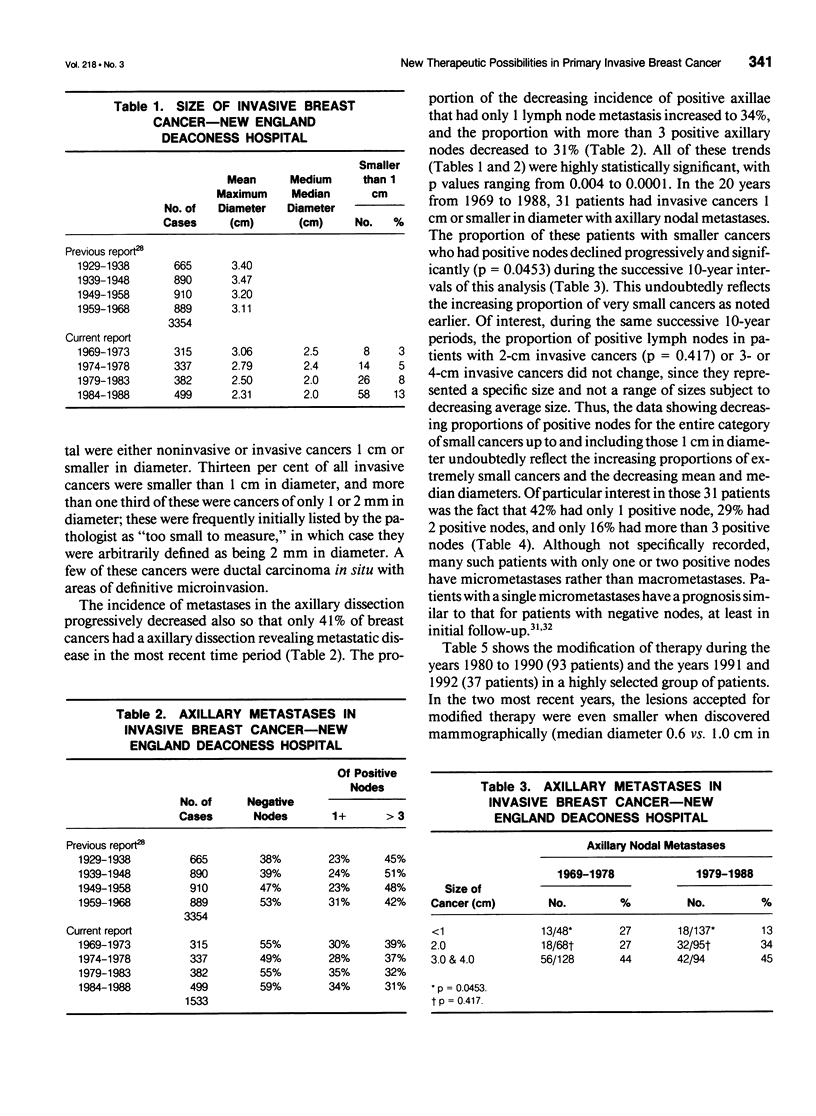
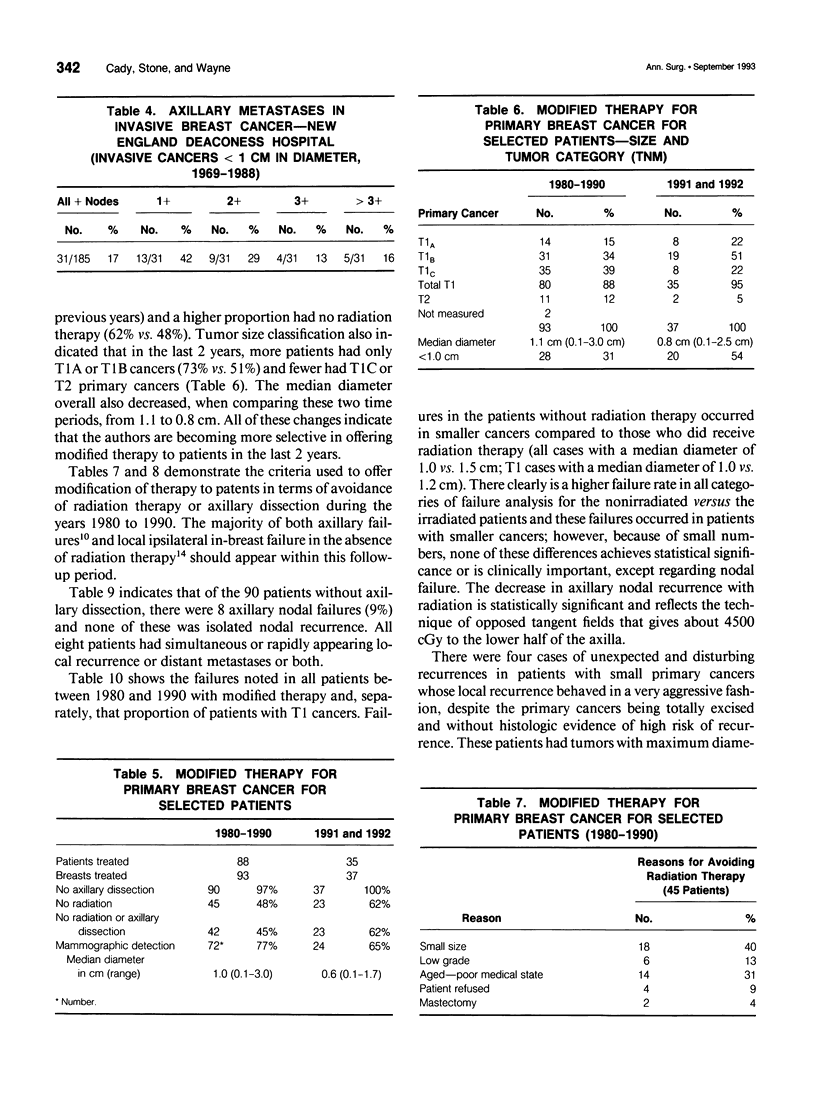
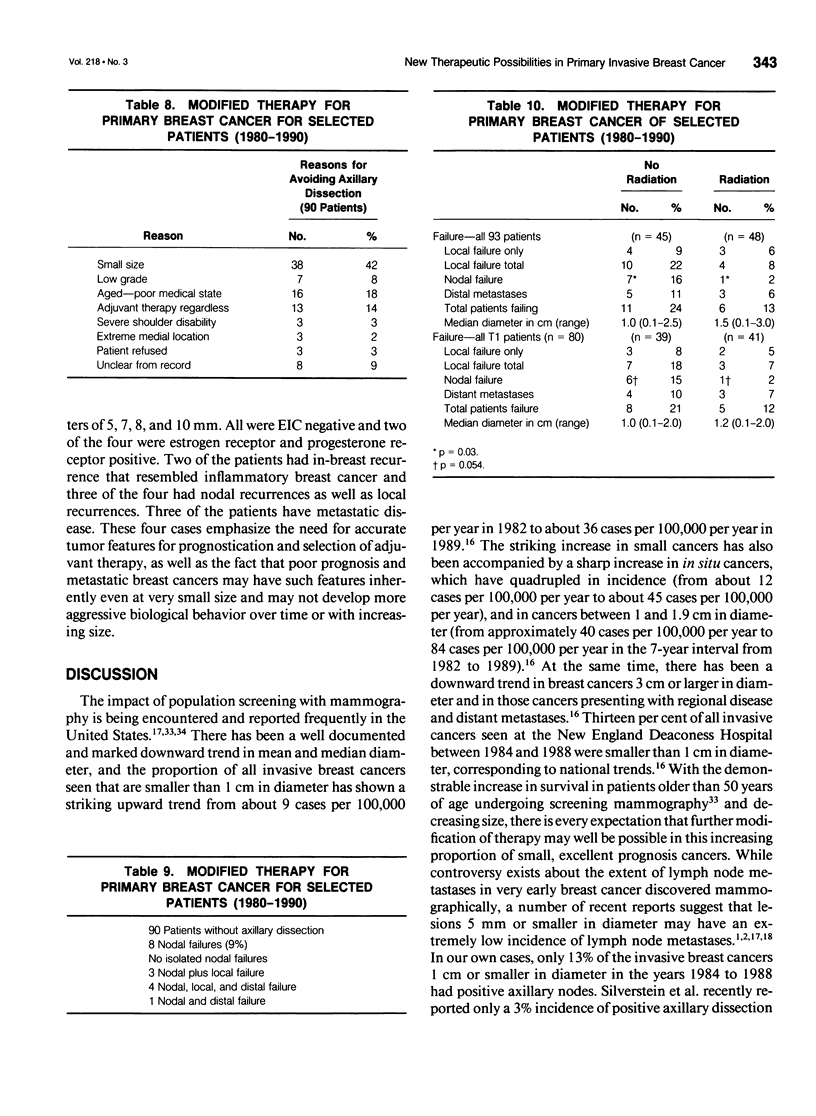
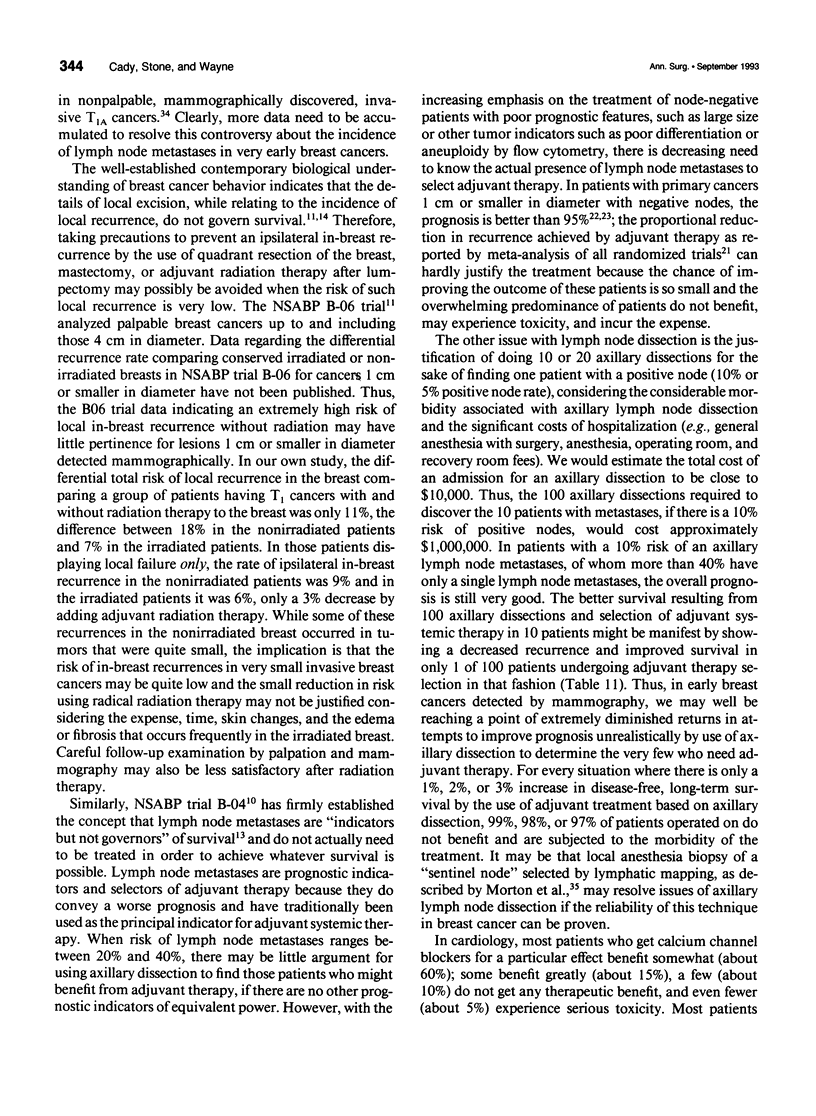
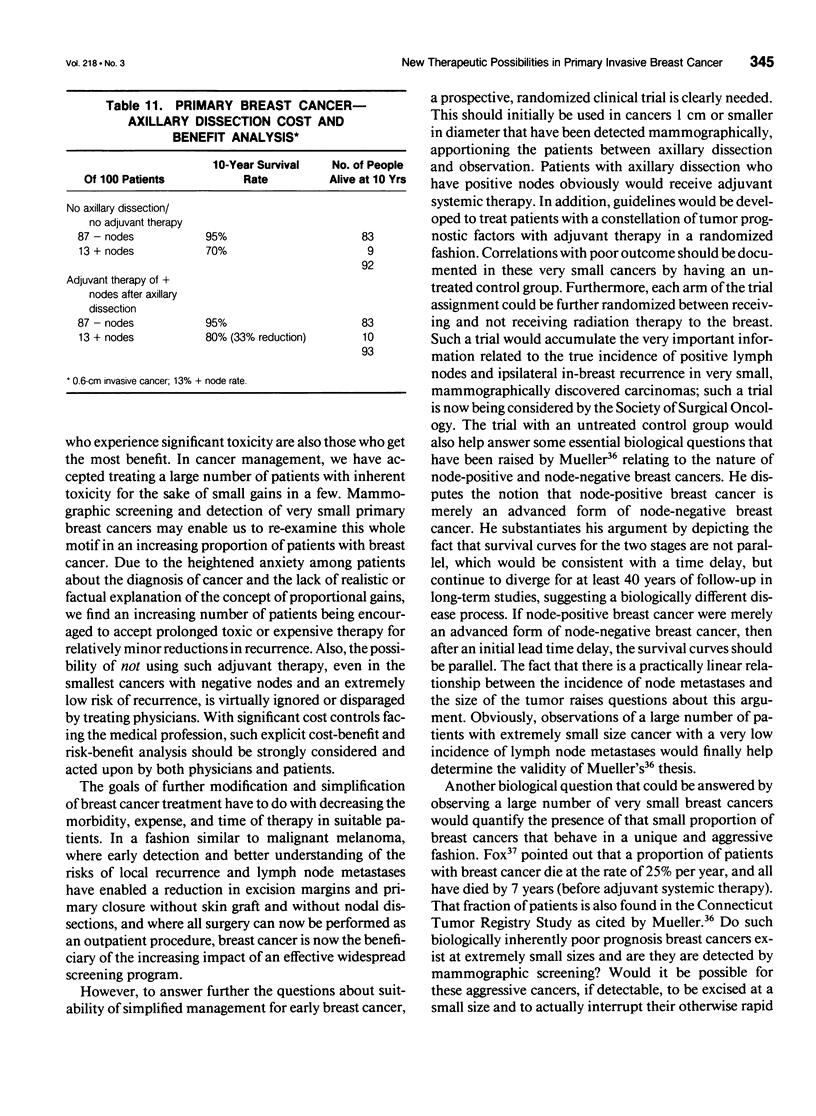
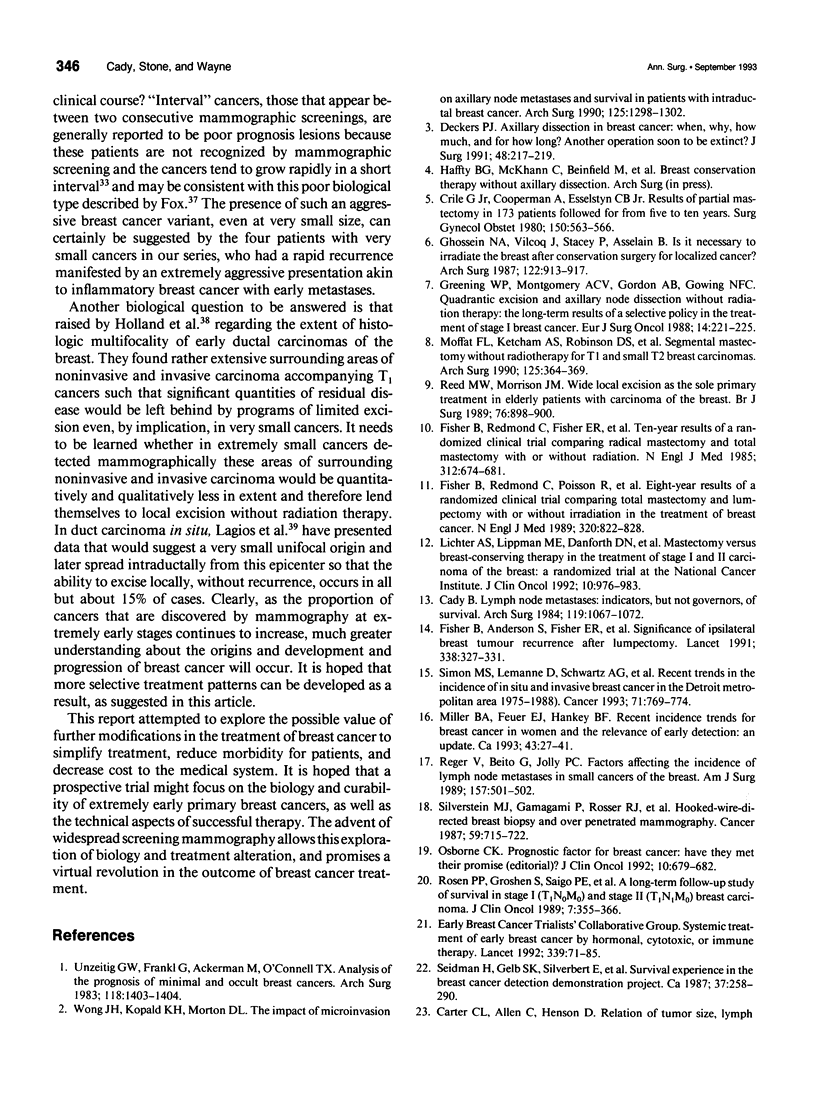
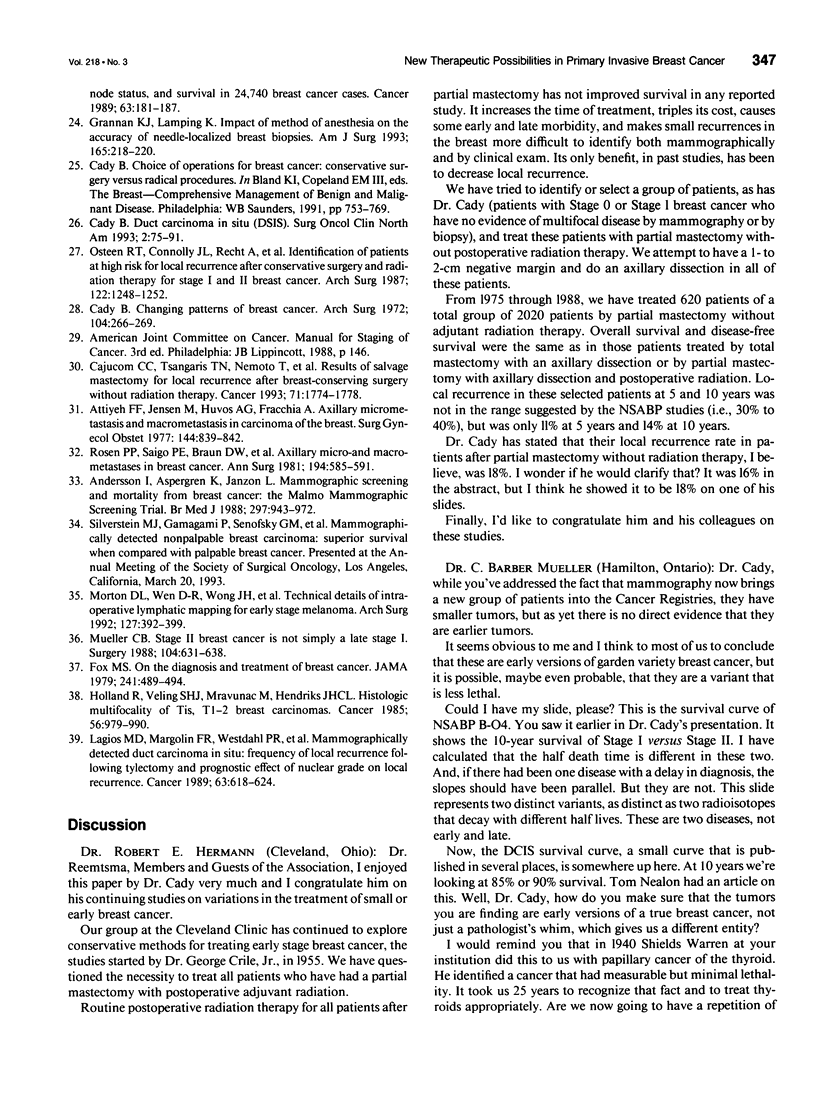
Selected References
These references are in PubMed. This may not be the complete list of references from this article.
- Andersson I., Aspegren K., Janzon L., Landberg T., Lindholm K., Linell F., Ljungberg O., Ranstam J., Sigfússon B. Mammographic screening and mortality from breast cancer: the Malmö mammographic screening trial. BMJ. 1988 Oct 15;297(6654):943–948. doi: 10.1136/bmj.297.6654.943. [DOI] [PMC free article] [PubMed] [Google Scholar]
- Attiyeh F. F., Jensen M., Huvos A. G., Fracchia A. Axillary micrometastasis and macrometastasis in carcinoma of the breast. Surg Gynecol Obstet. 1977 Jun;144(6):839–842. [PubMed] [Google Scholar]
- Cady B. Changing patterns of breast cancer. Arch Surg. 1972 Mar;104(3):266–269. doi: 10.1001/archsurg.1972.04180030014006. [DOI] [PubMed] [Google Scholar]
- Cady B. Lymph node metastases. Indicators, but not governors of survival. Arch Surg. 1984 Sep;119(9):1067–1072. doi: 10.1001/archsurg.1984.01390210063014. [DOI] [PubMed] [Google Scholar]
- Cajucom C. C., Tsangaris T. N., Nemoto T., Driscoll D., Penetrante R. B., Holyoke E. D. Results of salvage mastectomy for local recurrence after breast-conserving surgery without radiation therapy. Cancer. 1993 Mar 1;71(5):1774–1779. doi: 10.1002/1097-0142(19930301)71:5<1774::aid-cncr2820710511>3.0.co;2-v. [DOI] [PubMed] [Google Scholar]
- Crile G., Jr, Cooperman A., Esselstyn C. B., Jr, Hermann R. E. Results of partial mastectomy in 173 patients followed for from five to ten years. Surg Gynecol Obstet. 1980 Apr;150(4):563–566. [PubMed] [Google Scholar]
- Deckers P. J. Axillary dissection in breast cancer: when, why, how much, and for how long? Another operation soon to be extinct? J Surg Oncol. 1991 Dec;48(4):217–219. doi: 10.1002/jso.2930480402. [DOI] [PubMed] [Google Scholar]
- Fisher B., Anderson S., Fisher E. R., Redmond C., Wickerham D. L., Wolmark N., Mamounas E. P., Deutsch M., Margolese R. Significance of ipsilateral breast tumour recurrence after lumpectomy. Lancet. 1991 Aug 10;338(8763):327–331. doi: 10.1016/0140-6736(91)90475-5. [DOI] [PubMed] [Google Scholar]
- Fisher B., Redmond C., Fisher E. R., Bauer M., Wolmark N., Wickerham D. L., Deutsch M., Montague E., Margolese R., Foster R. Ten-year results of a randomized clinical trial comparing radical mastectomy and total mastectomy with or without radiation. N Engl J Med. 1985 Mar 14;312(11):674–681. doi: 10.1056/NEJM198503143121102. [DOI] [PubMed] [Google Scholar]
- Fisher B., Redmond C., Poisson R., Margolese R., Wolmark N., Wickerham L., Fisher E., Deutsch M., Caplan R., Pilch Y. Eight-year results of a randomized clinical trial comparing total mastectomy and lumpectomy with or without irradiation in the treatment of breast cancer. N Engl J Med. 1989 Mar 30;320(13):822–828. doi: 10.1056/NEJM198903303201302. [DOI] [PubMed] [Google Scholar]
- Fox M. S. On the diagnosis and treatment of breast cancer. JAMA. 1979 Feb 2;241(5):489–494. [PubMed] [Google Scholar]
- Ghossein N. A., Vilcoq J., Stacey P., Asselain B. Is it necessary to irradiate the breast after conservative surgery for localized cancer? Arch Surg. 1987 Aug;122(8):913–917. doi: 10.1001/archsurg.1987.01400200063011. [DOI] [PubMed] [Google Scholar]
- Grannan K. J., Lamping K. Impact of method of anesthesia on the accuracy of needle-localized breast biopsies. Am J Surg. 1993 Feb;165(2):218–220. doi: 10.1016/s0002-9610(05)80511-2. [DOI] [PubMed] [Google Scholar]
- Greening W. P., Montgomery A. C., Gordon A. B., Gowing N. F. Quadrantic excision and axillary node dissection without radiation therapy: the long-term results of a selective policy in the treatment of stage I breast cancer. Eur J Surg Oncol. 1988 Jun;14(3):221–225. [PubMed] [Google Scholar]
- Holland R., Veling S. H., Mravunac M., Hendriks J. H. Histologic multifocality of Tis, T1-2 breast carcinomas. Implications for clinical trials of breast-conserving surgery. Cancer. 1985 Sep 1;56(5):979–990. doi: 10.1002/1097-0142(19850901)56:5<979::aid-cncr2820560502>3.0.co;2-n. [DOI] [PubMed] [Google Scholar]
- Lagios M. D., Margolin F. R., Westdahl P. R., Rose M. R. Mammographically detected duct carcinoma in situ. Frequency of local recurrence following tylectomy and prognostic effect of nuclear grade on local recurrence. Cancer. 1989 Feb 15;63(4):618–624. doi: 10.1002/1097-0142(19890215)63:4<618::aid-cncr2820630403>3.0.co;2-j. [DOI] [PubMed] [Google Scholar]
- Lichter A. S., Lippman M. E., Danforth D. N., Jr, d'Angelo T., Steinberg S. M., deMoss E., MacDonald H. D., Reichert C. M., Merino M., Swain S. M. Mastectomy versus breast-conserving therapy in the treatment of stage I and II carcinoma of the breast: a randomized trial at the National Cancer Institute. J Clin Oncol. 1992 Jun;10(6):976–983. doi: 10.1200/JCO.1992.10.6.976. [DOI] [PubMed] [Google Scholar]
- Miller B. A., Feuer E. J., Hankey B. F. Recent incidence trends for breast cancer in women and the relevance of early detection: an update. CA Cancer J Clin. 1993 Jan-Feb;43(1):27–41. doi: 10.3322/canjclin.43.1.27. [DOI] [PubMed] [Google Scholar]
- Moffat F. L., Ketcham A. S., Robinson D. S., Legaspi A., Ghandur-Mnaymneh L., Hilsenbeck S. Segmental mastectomy without radiotherapy for T1 and small T2 breast carcinomas. Arch Surg. 1990 Mar;125(3):364–369. doi: 10.1001/archsurg.1990.01410150086016. [DOI] [PubMed] [Google Scholar]
- Morton D. L., Wen D. R., Wong J. H., Economou J. S., Cagle L. A., Storm F. K., Foshag L. J., Cochran A. J. Technical details of intraoperative lymphatic mapping for early stage melanoma. Arch Surg. 1992 Apr;127(4):392–399. doi: 10.1001/archsurg.1992.01420040034005. [DOI] [PubMed] [Google Scholar]
- Mueller C. B. Stage II breast cancer is not simply a late stage I. Surgery. 1988 Oct;104(4):631–638. [PubMed] [Google Scholar]
- Osborne C. K. Prognostic factors for breast cancer: have they met their promise? J Clin Oncol. 1992 May;10(5):679–682. doi: 10.1200/JCO.1992.10.5.679. [DOI] [PubMed] [Google Scholar]
- Osteen R. T., Connolly J. L., Recht A., Silver B., Schnitt S. J., Harris J. R. Identification of patients at high risk for local recurrence after conservative surgery and radiation therapy for stage I or II breast cancer. Arch Surg. 1987 Nov;122(11):1248–1252. doi: 10.1001/archsurg.1987.01400230034005. [DOI] [PubMed] [Google Scholar]
- Reed M. W., Morrison J. M. Wide local excision as the sole primary treatment in elderly patients with carcinoma of the breast. Br J Surg. 1989 Sep;76(9):898–900. doi: 10.1002/bjs.1800760908. [DOI] [PubMed] [Google Scholar]
- Reger V., Beito G., Jolly P. C. Factors affecting the incidence of lymph node metastases in small cancers of the breast. Am J Surg. 1989 May;157(5):501–502. doi: 10.1016/0002-9610(89)90645-4. [DOI] [PubMed] [Google Scholar]
- Rosen P. P., Saigo P. E., Braun D. W., Weathers E., Fracchia A. A., Kinne D. W. Axillary micro- and macrometastases in breast cancer: prognostic significance of tumor size. Ann Surg. 1981 Nov;194(5):585–591. doi: 10.1097/00000658-198111000-00006. [DOI] [PMC free article] [PubMed] [Google Scholar]
- Rosen P. R., Groshen S., Saigo P. E., Kinne D. W., Hellman S. A long-term follow-up study of survival in stage I (T1N0M0) and stage II (T1N1M0) breast carcinoma. J Clin Oncol. 1989 Mar;7(3):355–366. doi: 10.1200/JCO.1989.7.3.355. [DOI] [PubMed] [Google Scholar]
- Seidman H., Gelb S. K., Silverberg E., LaVerda N., Lubera J. A. Survival experience in the Breast Cancer Detection Demonstration Project. CA Cancer J Clin. 1987 Sep-Oct;37(5):258–290. doi: 10.3322/canjclin.37.5.258. [DOI] [PubMed] [Google Scholar]
- Silverstein M. J., Gamagami P., Rosser R. J., Gierson E. D., Colburn W. J., Handel N., Fingerhut A. G., Lewinsky B. S., Hoffman R. S., Waisman J. R. Hooked-wire-directed breast biopsy and overpenetrated mammography. Cancer. 1987 Feb 15;59(4):715–722. doi: 10.1002/1097-0142(19870215)59:4<715::aid-cncr2820590409>3.0.co;2-c. [DOI] [PubMed] [Google Scholar]
- Simon M. S., Lemanne D., Schwartz A. G., Martino S., Swanson G. M. Recent trends in the incidence of in situ and invasive breast cancer in the Detroit metropolitan area (1975-1988). Cancer. 1993 Feb 1;71(3):769–774. doi: 10.1002/1097-0142(19930201)71:3<769::aid-cncr2820710320>3.0.co;2-4. [DOI] [PubMed] [Google Scholar]
- Unzeitig G. W., Frankl G., Ackerman M., O'Connell T. X. Analysis of the prognosis of minimal and occult breast cancers. Arch Surg. 1983 Dec;118(12):1403–1404. doi: 10.1001/archsurg.1983.01390120033009. [DOI] [PubMed] [Google Scholar]
- Wong J. H., Kopald K. H., Morton D. L. The impact of microinvasion on axillary node metastases and survival in patients with intraductal breast cancer. Arch Surg. 1990 Oct;125(10):1298–1302. doi: 10.1001/archsurg.1990.01410220082011. [DOI] [PubMed] [Google Scholar]


